Monday Media Madness: Just How Fabulous Were Those Secret Powers?
Every Monday, Matt. Murray reviews, revisits and rambles about comics, cartoons and their interactions in and with related media.
by Matt. Murray
My one big, exciting purchase at this year’s New York Comic Con was the “Exclusive” Faker figure from Mattel’s Master’s of the Universe Classics line.
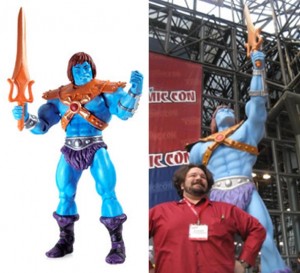
(For the uninitiated, Faker, aka Faker I, was a robotic clone of He-Man used by Skeletor to carry out nefarious schemes.)
By now, it’s probably on sale at their website, but knowing that I was one of the first to have one of these guys in my filthy fanboy mitts made me rather excited.
In fact, it brought me back to the Christmas time of 1983 when my brother started to beat me up and I started crying at the top of my lungs as I feebly smacked back at him. My frazzled mother came on to the porch, broke us up, and told us that if we weren’t good we wouldn’t be getting any presents for Christmas.
The smug little wiseacre that I was, I chimed in and said: “Yeah, Brian. You better be good or Santa’s only gonna come for me.”
Of course, he punched me again. Of course, I started crying, again.
My mother, perpetually at the end of her rope, but in this instance particularly end-of-ropey, shouted: “Stop! You want something to cry about, I’ll give you something to cry about! I’m Santa!” She went to the closet, whipped out a carded, blister-packed figure. “Do you want this? Then SHUT UP!”
It was Faker. Of course I wanted him. So I shut up, and silently mourned the passing of the Santa Claus myth.
Good times.
None of that stopped me from enjoying the living hell out of that doll when I ripped him open on Christmas morning, though. As a child I didn’t just consume, I downright devoured me some He-Man. The toys. The cartoon. The Panini sticker book. The Dixie cups. I was frakkin’ gay about He-Man, so to speak.
I guess you can probably see where this is going…
But was He-Man gay about me? Or even, just plain gay?
Well, a lot of people would have you believe that toy makers Mattel and Filmation Associates, producers of He-Man and the Masters of the Universe cartoon series, in their own ham-handed way wanted you infer that. Simply take a look at this completely de-contextualized original artwork:
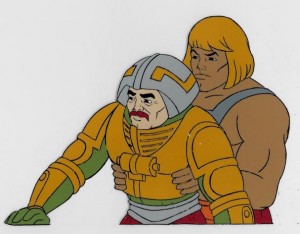

and this heavily edited and re-mixed video:
and let us snarky internet people decide for you.
Or, for a better answer, you can turn to He-Man’s self-proclaimed “real creator” (the seeds of his actual creation are the subject of debate), Roger Sweet, who chronicled his perception of the birth of the “Most Powerful Man in the Universe” in Mastering the Universe: He-Man and the Rise and Fall of a Billion Dollar Idea (w/ David Wecker, Emmis Books, 2005).
When I read the book in preparation for a 2006 exhibit I curated on the art and commerce of Saturday morning cartoons, I was intrigued by what I found. The original Masters of the Universe toy line (commonly referred to as MOTU) – on which all interpretations of He-Man and his characters were, are and will be somewhat based – was not a secret plot by Mattel, manufacturers of Barbie, to feminize the next generation of boys by infiltrating their playthings with a closeted homosexual who “comes out” by firmly grasping a giant sword and proclaiming his power.
Instead, if you want to believe Sweet, he was the creation of a frail boy, who had grown into a weightlifting enthusiast, perhaps to make up for what he felt was his shorter, weaker physical stature. Sweet was fueled by Pumping Iron (the 1977 documentary about Arnold Schwarzenegger’s capturing of the Mister Universe title), the Charles Atlas ads found in comics of the Silver Age and a desire to dominate the MAF (toy biz lingo for Male Action Figure) market that was then ruled by Star Wars toys.
In 1980, Sweet took some Mattel Big Jim figures and re-sculpted them into a trio of “Space Military,” “Current Military” and “Barbarian Monster Fantasy” dolls. At a presentation for execs to pitch new toys, Mattel’s then president, Ray Wagner, pointed to the rudimentary sculpts and quietly stated: “Those have the power” – essentially green-lighting the concept into production, and unknowingly creating a battle cry and catchphrase for the ages.
After being worked on by the marketing and art departments the MOTU line became a mixture of all three concepts – space, military and barbarian – freeing them of any specific time line or Earth bound history. The line’s star, He-Man, was so named to inspire an air of unabashed masculinity, and was depicted as a Frazetta-esque savage barbarian in a savage land in the mini-comics that were produced and included with the first few waves of figures.
MOTU were produced at a 5 inch scale, with the purpose of towering over 3.75 inch Star Wars and the (then) newly relaunched and re-designed G.I. Joe lines. They were also given spring-loaded battle-action waists, truly making them “action” figures, as opposed to the static, poorly articulated Jedi they were competing against. He-Man, his companions and sworn enemies were each given a “bent-limbed, ready to pounce forward crouch, coupled with a hard-bitten, ferocious facial expression” – factors which Sweet constantly attributes to the line’s success as an MAF, earning $38 million in its first year (1982) during an era where a mere $10 – 15 million marked a thriving property.
The sales exploded over the subsequent years – jumping to $80 then $111 then $250 million dollars with each year’s wave of new toys – a fact that Sweet is too eager to attribute to his months of accumulated overtime and that “kick-ass expression” and “battle ready stance” of his initial character. He vastly underplays one key factor: the 1983 debut of Filmation’s He-Man and the Masters of the Universe animated cartoon, which premiered in syndication and ran for 130 episodes. Then re-ran, and re-ran, and re-ran… Pummeling a love for the characters and need for their merchandise into the minds of children around the world. (The show ran in dozens of countries besides the United States, including England, France, Iceland, Australia and Argentina.)
In their book, Sweet and his co-author barely dedicate four pages to the show. They choose to breeze over the series briefly, if only to mention that it was merely a marketing tool for the figures and that the show was more popular for inspiring controversy amongst churches and parent groups than for being any good. If you read parts of the book aloud, you can actually taste the palpable resentment when he mentions that Filmation chose to develop Prince Adam as a “sissified” secret identity for He-Man, and then demanded royalties on the figure that was made of him.
Though he and Wecker try to treat the subject in an off-handed “not bitter at all” style, Sweet brings up the fact that he received no royalties, let alone proper credit, enough times to possibly explain the writing of the book.
He can take credit for the book (half of it at least.) He can collect royalties on the book (again half, but good enough). And, perhaps, he can set the record straight, pun intended, on He-Man’s masculinity with the book.
He-Man, as Sweet sees it, was his creation. I may be reading between the lines here, but this particular creation seems to be an expression of Sweet’s own masculinity and virility. (Another expression being the way he seemingly sums up every male co-worker as a physical specimen citing their approximate heights, weights and physical builds as if he were assessing whether or not he could take them in a fight.) His creation was clearly and most definitely “straight” – and this is my editorial now – despite the fact that it may have been making up for some perceived physical short-comings. He-Man may have only been five inches tall, but those are five wide inches of “r-r-rippling muscles” that were “bigger than anything else on the market.” (Quotes are Sweet’s.)
In thinking about it, for a decidedly straight idea – it does sound pretty gay. Gayer when you add Adam, who Sweet himself refers to as a sissy.
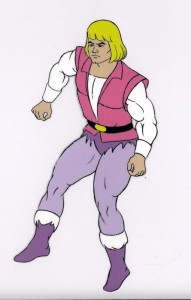
After doing some more digging into the series, I have decided that this friction is perhaps what Michael Halperin responded to when he was hired to create the series bible and act as the Mattel/Filmation liaison for the show.
Halperin wrote Prince Adam’s back story, and according to a 1998 interview had a different perception of the character as “a seventeen year old boy. When he makes the change, he would become He-Man (muscles, armor, and definitely would not look the same). Economics changed that.”
The economics he was referring to were perhaps the economics of animating a show for Filmation, which required few character models, and sequences of drawings that could be shot over numerous different backgrounds and used in any situation – animation stock footage, if you will. This could have been reinforced by the economics of toy production, which itself required the use and reuse of specific molds in different combinations to modularly create “new” figures (a process Sweet pats himself on the back for in opting to use it for the MOTU line.) Both budgets must have demanded that the two look almost exactly alike.
If they had to look alike, then logically the only way to effectively differentiate the characters would be to make the “two” polar opposites in writing and performance. If He-Man was so completely masculine, wouldn’t Adam then, have to be feminine?
The effete alter-ego is a device as old as dual identity heroes themselves. The Scarlet Pimpernel fell into the persona of “foppish” Sir Percy Blakeney when out of the mask, Superman became the “nebbish” Clark Kent, etc.
Those identities, however, were adults, and were able to pursue women to somewhat comically disastrous ends, while Adam, a child forced into a man’s body by budgetary constrictions, essentially had no sex drive. Of course, he was destined to be perceived as gay; the pink tunic and purple tights didn’t help his defense any.
So, was He-Man gay? I guess the short answer based on the evidence uncovered and logically interpreted would be no.
Was Prince Adam? Probably not, but his teenaged ambiguity and role as a direct foil to He-Man leave him open to speculation, if someone’s looking to interpret him in that way.
Does it really matter? Well, if someone’s looking to hang their hopes on a positive role model for a homosexual teen or child, or trying to associate a hero with their own sexual identity, then I guess in those instances the answer is: Yes, it does matter. But no, he’s still not gay.
However, why would anyone look to He-Man for that, when there are plenty of other characters that are clearly queer and ready to take up the cause?
Take She-Ra’s Bow, for example. That guy was completely gay.
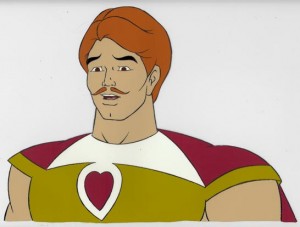
All characters are property of their respective copyright holders. He-Man and the Masters of the Universe and She-Ra, Princess of Power original artwork featured in this post is currently on loan to the Sequential Art Collective from a private collection.
Matt. Murray earned his BFA in film, television and radio production from NYU. He has curated exhibits focusing on the art and commerce of Saturday Morning cartoons and the adaptation of illustrated media into live actions films and animation. Murray is the country’s leading (if not only) Smurfologist. His personal blog, It’s Time for Some Action, can be found at http://actnmatt.blogspot.com/
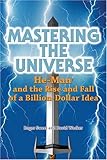



No comments yet.